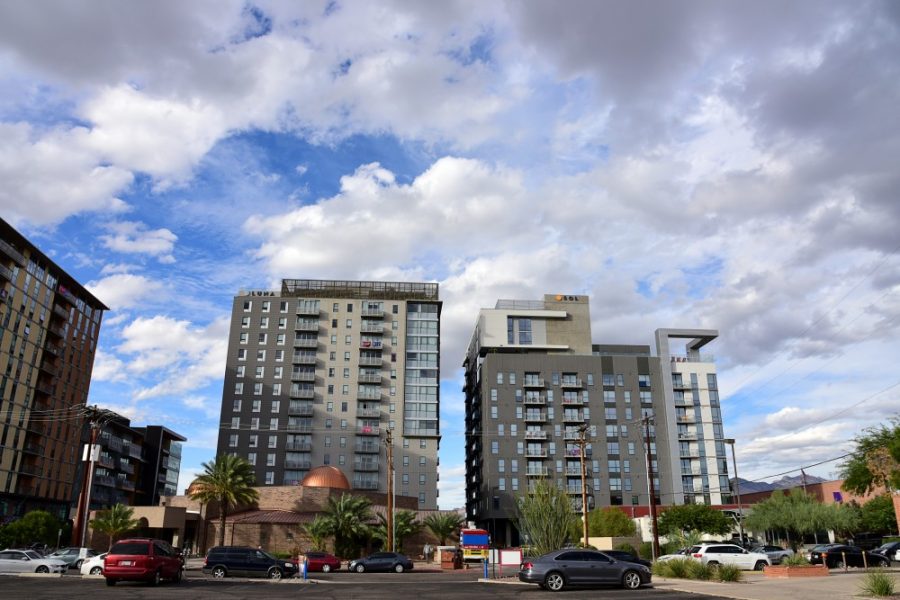Luxury student housing developments have become a standard part of Tucson’s landscape in recent years. Aspire Tucson is being built on Tyndall Avenue next to Sol y Luna, another luxury development.
This process began in the 1990s when private property developers began looking into creating off-campus housing developments for students. Tucson has recently seen a growing number of these types of developments around campus, with high-rises becoming a mainstay in the immediate area.
“We’re in the path of progress, but that doesn’t mean it’s going to be progress for people that live in the barrios,” said Brian Flagg, who works with the Casa Maria Soup Kitchen and the Barrio-Neighborhood Coalition in South Tucson. “If you look at how gentrification works in cities around the country, a whole bunch of people around here will get displaced.”
Off-campus housing developments, especially luxury ones often advertised in UA’s Off-Campus Housing guides, typically feature rent prices 30-40 percent higher than average housing.
With the opening of the Honors Village in fall 2019, there will be approximately 7,540 student resident slots offered through the University of Arizona. Rent in the dorms typically ranges from $6,390 to $12,930 depending on which residence hall and the type of dorm room. These costs break down to around $700 to $1,500 a month, with the average prices reaching similar levels as the off-campus developments.
Steve Kozachik, the current council member for Ward 6, which encompasses a large area around campus, said that developers should “build within the campus footprint.”
Developers would instead work with already existing dorms or within campus grounds to build student housing developments. “It alleviates the stress on surrounding neighborhoods,” Kozachik said.
The university rarely overhauls entire dorms to update them for affordability or to more recent standards and similar quality as the off-campus developments.
RELATED: Tall, dense high-rises draw ire of surrounding neighborhood
“If you did something like demolish [the Apache-Santa Cruz] dorm, which is a concrete bunker that’s about 60 years old, and build one of these things down that footprint, seems to me it makes more sense,” Kozachik said. “Student housing developers, the private sector, they can still make their cash off of something like that.”
The Honors Village is set to cost $137 million, but little has been said about other forms of potential revitalization programs. The project is partnered with American Campus Communities, a developer and manager of student housing, to finance, construct and operate the new dorms, forming a public-private partnership and potential model for future developments moving forward.
“So, the model exists, but the reason they’re coming is that there is money to be made and they do not believe that they’ve reached saturation,” Kozachik said.
While routes for citizens do exist, Flagg criticizes that they aren’t listened to and should instead be appointed by neighborhoods and have real power.
Student housing developments require a group dwelling designation, which requires specific zoning to be built. Often the process to rezone can be time-consuming, a recent case being the Benedictine Monastery, where developers decided not to build student housing after community push-back and are now going through the rezoning process.
The Honors Village development also avoided the rezoning processes required in normal circumstances, exemplifying a key aspect of where and why high-rise developments are built. By working with the ACC on a ground lease, the area became state land and thus exempt from city zoning laws, which according to Kozachik, angered a lot of residents, as they bypassed the processes typically required.
“Bill Viner spearheaded and worked with [Tucson Mayor Jonathan Rothschild] to completely redo a huge overlay zone over properties west of the UofA to allow properties to be rezoned for high-rise student housing,” said Jim Marian, a real estate agent at Chapman Lindsey who has worked on several student housing developments, including one of the first high-rise developments around campus. “[Student housing developments] are some of the only properties that there’s an overlay zone in place to do it.”
RELATED: OPINION: Gentrification in Tucson
The overlay zone was adopted on Feb. 28, 2018 and established an urban overlay district within the West University area called the Main Gate District. This ordinance allowed for various height increases for certain parts of the district, reaching 14 stories at the highest point, but the zoning required at minimum 0.5 parking spaces per unit, circumventing typical parking regulations and allowing for high-rise residences with minimal parking.
By building within the campus footprint, Kozachik stated that it would alleviate stress both in rezoning processes and for the neighborhoods surrounding the campus.
The streetcar has discouraged construction of parking spaces as well, Marian said.
According to Marian, the streetcar’s construction allowed for “the ability to build high-rises where you didn’t need to meet parking requirements due to the availability of ‘walkability’ and public transportation. If the streetcar wasn’t there you’d probably have to put in five or six stories of parking garages before you could put a unit that would generate an income.”
According to Flagg, the UA is “investing in trying to get students who can pay out-of-state tuition and who can ride the city-funded streetcar.”
Despite increasing amenities downtown and the surrounding high-rise student housing developments, these residences and new portions of downtown are inaccessible for a large portion of the Tucson population. The median household income of Tucson is $39,617, according to census data taken from 2013 through 2017. This leaves many of the developments to be housed by out-of-state students, who made up 33.2 percent of the fall 2018 enrollment numbers, typically paying $34,967 for out-of-state tuition, compared to $11,769 for in-state.
There are differing opinions on the abundance of high-rise developments. Some, like Marian, say that the benefits for downtown, especially from the streetcar, have contributed to Tucson.
“The University market is its own market,” Marian said. “It’s not going to impact Tucson and the Tucson market is not going to impact that much.”
This would leave the greater Tucson market primarily unaffected by the discrepancies in rent costs between average housing and the student housing high-rises.
Flagg also criticized governmental incentive programs like the Rio Nuevo and GPLET for offering assistance to private developments that don’t benefit the community.
“Immediately adjacent to or right in the middle of a residential area, the impacts [of student housing developments] in terms of traffic, in terms of noise, in terms of just the added density to the surrounding area is difficult for people who’ve made long term investments in their property,” Kozachik said. “What happens 20 years from now when the demand recedes?”
There are many stakeholders involved in the process, and the conversation will continue as developments are built from residents to government and private developers.
“People have roots in the neighborhood around here,” Flagg said. “For me, it’s not an intellectual thing, it’s a real thing.”
Follow the Daily Wildcat on Twitter








